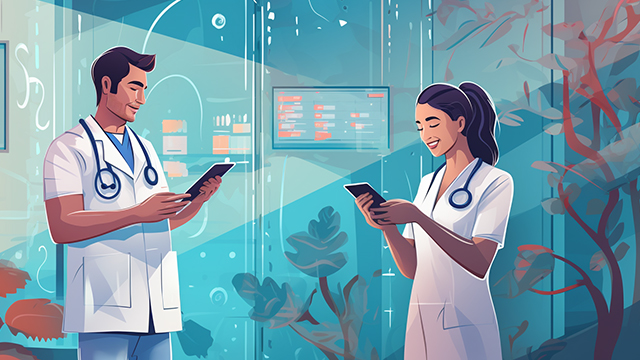Navigating Advances in Healthcare Wearables
Healthcare providers need your expertise to implement reliable systems that collect vital patient data.
BlueStar's diverse portfolio offers unparalleled access to premium products and services that drive business growth and success. From state-of-the-art hardware to advanced software solutions, our portfolio is designed to empower businesses with the tools they need to thrive in today's competitive landscape.
Our vertical-based content focuses on different industry technologies, solutions, and insights.
A true VAD offers top-notch pick, pack and ship services, and provides programs and services that add value to the distributed products that increase their value or worth.
The BlueStar Difference
Healthcare organizations are looking for TSPs with a broad range of tech expertise and solutions to some of the industry’s most pressing problems.
Technology solutions providers (TSPs) serving the healthcare industry are challenged to keep up with rapid innovation in this space. However, challenges create opportunities. Healthcare is ready for digital transformation to improve care delivery, access, and patient outcomes.
Educate yourself about what’s driving these five healthcare IT trends, the solutions healthcare providers need to overcome pain points and meet patient expectations, and how you can position your business in the market.
HIMSS and its Trust Partners, including Accenture, The Chartis Group, and ZS Associates, surveyed patients, providers, payers, and health system leaders in the UK, Germany, Australia, New Zealand, and the US for its 2022 Future of Healthcare Report. Of the clinicians surveyed, 79 percent believe technology will play a critical role in patient interactions. Furthermore, 50 percent of patients in the UK and Germany are willing to share digital health data to receive more personalized care.
Wearable devices allow patients to monitor blood pressure, blood glucose, oxygen, and other vital signs that can indicate the first signs a patient needs intervention. Wearables include familiar form factors, such as smartwatches, but they also include sensors embedded in clothing, electronic tattoos, and wearable drug delivery systems.
Healthcare providers may need your expertise to share wearables data securely and reliably in a format that their electronic health record (EHR) system can use.
The HIMSS study found that 65 percent of clinicians believe remote monitoring will be the most in-demand digital health tool in the next five years. Remote patient monitoring solves the problem of healthcare access to patients in locations with limited healthcare facilities. In combination with telehealth, it enables clinicians to manage patients’ conditions without requiring them to travel.
Remote patient monitoring requires a solid plan for setting up equipment in the patient’s home and providing easy-to-follow instructions. It also requires cybersecurity solutions to ensure that nothing will interfere with system functions or data privacy. In addition, 5G communications will enhance these systems with greater transmission speed, lower latency, and support for more devices in a geographic area compared to 4G.
AI and machine learning give healthcare practitioners the ability to search massive datasets in just a few seconds, which can reduce the time for clinical trials, make data more accessible, and enable personalized treatments for cancer or other life-threatening conditions.
Additionally, the NHS in the UK is testing AI analysis of CT scans to automate the process with promising results. The world’s largest corporations can see the potential in this area. Microsoft has jumped into the space with its Project InnerEye. Project InnerEye is the result of research conducted by Microsoft in Cambridge, UK, in the hopes of assisting clinicians in planning their radiotherapy treatments more quickly, freeing them up to spend more time with their patients.
To gain the benefits of AI and machine learning solutions, they need a model for their use case, datasets to train it, and dashboards or other user interfaces to access insights and visualizations. They also need a way to manage data securely, possibly dynamic data from APIs in addition to the data that the healthcare system stores. You can collaborate or partner to bring total solutions to your healthcare clients.
3D printing has become familiar in a range of industries for rapid prototyping, architectural design, and bespoke manufacturing. In healthcare, the technology is the basis for bioprinting. Bioprinting is a branch of regenerative medicine currently under development where simple human tissues can be printed. This technology is still in its infancy, but healthcare practitioners have successfully printed tissues for product testing to eliminate the need for animal testing, prosthetics for transplant, cartilage, and personalized stents.
Healthcare Trends That Demand Solutions
In addition to healthcare IT trends, there are two prevalent industry challenges that TSPs can help their healthcare clients overcome.
The Big Picture
Healthcare providers aren’t only interested in solving the problem at hand; They ultimately want to improve care, patient experiences, and a healthy work culture for their employees and staff. TSPs that keep healthcare organizations’ primary objectives in mind will find the greatest success.
Consider how your solutions can help healthcare organizations meet their most important goals.

Healthcare providers need your expertise to implement reliable systems that collect vital patient data.

Healthcare is a notoriously difficult industry to sell to. Winning a deal can be incredibly lucrative and foster lengthy relationships, but it also...

Information is vital to quality healthcare. The solutions you provide can keep the lines of communication open.